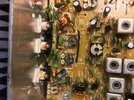Couldn't have done it without you being there to help Andy. The way you detail things helps more than you know. You're not spoonfeeding, you're educating others in the process.
I've informed the owner and he's excited to get it back. I did finally ask him why the connection to this specific radio and he told me his dad bought it for him before he passed. I think I made the right decision in not charging him for this. He's truly a good kid (kid to me, lol).
With the upgraded regulators and proper ma, volts, etc...this radio should last him a while. I know it's not perfect, but it's back from the closet of death, lol...
Now, I can jump back on the superstar 3900 with the same board. I think I have another thread on this site for that radio.
The guy wanted me to tell you again Andy, thank you, thank you and God Bless you. And I feel the same Andy, thank you for being so kind, patient and helpful.
I've informed the owner and he's excited to get it back. I did finally ask him why the connection to this specific radio and he told me his dad bought it for him before he passed. I think I made the right decision in not charging him for this. He's truly a good kid (kid to me, lol).
With the upgraded regulators and proper ma, volts, etc...this radio should last him a while. I know it's not perfect, but it's back from the closet of death, lol...
Now, I can jump back on the superstar 3900 with the same board. I think I have another thread on this site for that radio.
The guy wanted me to tell you again Andy, thank you, thank you and God Bless you. And I feel the same Andy, thank you for being so kind, patient and helpful.








